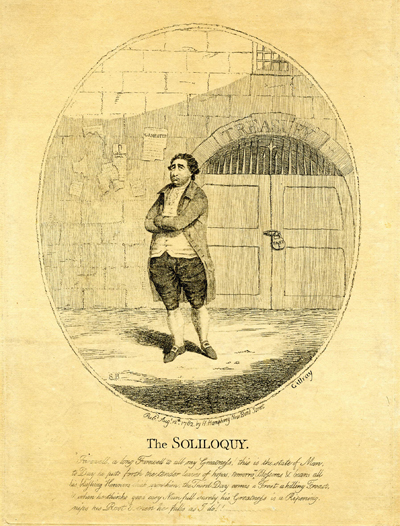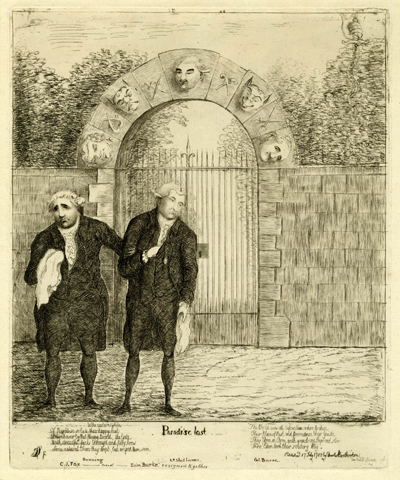The Soliloquy
This is one of several prints in 1782 that depict Charles James Fox after he resigned in protest from the Shelburne ministry hoping to discredit it. Others include Gloria Mundi, or the Devil Addressing the Sun and Ahitophel in the Dumps, both in July, Guy Vaux & Judas Iscariot in August, and Aside He Turn'd for Envy in December. In each case Fox is implicitly compared to an evil and/or ambitious character: Satan (especially the Satan of Milton's Paradise lost), Ahitophel from the Old Testament, and the historical/legendary Guy Vaux.

© Trustees of the British Museum
In The Soliloquy the implicit comparison is to another over-reacher, Cardinal Wolsey who, like Fox, fell from greatness, and whose soliloquy from Shakespeare's Henry the Eight, Act 3, Scene 2 is borrowed by Gillray for his subtitle.
Farewell, a long farewell to all my greatness!
This is the state of man: to-day he puts forth
The tender leaves of hopes, to-morrow blossoms,
And bears his blushing honors thick upon him;
The third day comes a frost, a killing frost,
And when he thinks, good easy man, full surely
His greatness is a-ripening, nips his root,
And then he falls as I do.
The general organization of the print is clearly influenced by James Sayers print, Paradise Lost which appeared in July. Like the Sayers print, Fox stands before a stone arch with a locked gate of iron spikes that symbolizes the Shelburne ministry from which he was now excluded. In the Sayers print, of course, Fox is accompanied by Burke, and the gate is to the general "Paradise" of office.

© Trustees of the British Museum
In The Soliloquy the gate is specifically labeled Treasury, the office held by Shelburne himself. The space before the Treasury has an almost stage-like quality with a spotlight on the disgruntled Fox. Behind him on the wall are two torn placards that further identify Fox (Gamester) and characterize the desperation of his position (Last Dying Speech).
To look at The Soliloquy in relation to Sayers' Paradise Lost, however, is to recognize, even in 1782, the superiority of Gillray as an artist. Sayers' design is unbalanced with both Burke and Fox crowded left. The figures are flat and awkwardly posed. And in the upper right corner of the print, a hand holding a sword inscribed, "Commission to the Lord of ye Treasury" is virtually invisible, obscured by what is supposed to be Edenic foliage.
The arch in Gillray's The Soliloquy, on the other hand, is echoed and reinforced by the oval frame of the print itself. The arch combined with the rounded figure of Fox suggests indeed an oval within the oval. The (properly centered) portrait of Fox has real weight and depth, and his pose subtly suggests an actor stepping forward and about to begin his soliloquy.
Sources and Reading
- Commentary from the British Museum on The Soliloquy
- Shakespeare, Henry VIII Act III, Scene 2
Comments & Corrections
NOTE: Comments and/or corrections are always appreciated. To make that easier, I have included a form below that you can use. I promise never to share any of the info provided without your express permission.